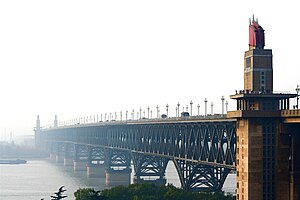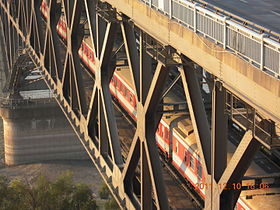Nanjing Yangtze Bridge
Coordinates: 32 ° 6 ′ 55 ″ N , 118 ° 44 ′ 20 ″ E
| Nanjing Yangtze Bridge | ||
|---|---|---|
| View of the steel structure | ||
| use | Railway and road bridge | |
| Crossing of | Yangtze River | |
| construction | Double deck bridge | |
| overall length | 1,557 m steel construction 6,772 m with access ramps |
|
| width | 15 m | |
| start of building | 1960 | |
| opening | 1968 | |
| location | ||
|
|
||
The Nanjing-Yangtze Bridge , often also called the First Nanjing-Yangtze Bridge , is a combined road and rail bridge in Nanjing , the capital of the Chinese province of Jiangsu .
history
After the Second Sino-Japanese War , the Chinese rail network was in poor condition. Reconstruction began immediately after the founding of the People's Republic of China , so that the route length before the war was exceeded in the mid-1950s. For the further expansion of the railroad, the large rivers running in a west-east direction represented an increasing problem, because they prevented the merging of the subnetworks that had been created. The construction of large, connecting bridges was therefore given high priority. After the Yangtze Bridge in Wuhan was completed in 1957 as the first bridge over the Yangtze , the longest river in China, construction of the Nanjing-Yangste Bridge began in 1960 by Soviet engineers, who left the country during the construction phase. Before that, the Yangtze River near Nanjing was crossed by a train ferry . In 1968 the bridge was opened to traffic as the first Chinese bridge of this size that was not completed by foreign engineers.
The Second Nanjing-Yangtze Bridge was opened in 2001 , the Third Nanjing-Yangtze Bridge in 2005 and the Fourth Nanjing-Yangtze Bridge in 2012 to cope with the increase in road traffic . As the rail traffic on the double-track Jangste Bridge increased continuously, the Dashengguan Bridge , which has six tracks for high-speed traffic and the Nanjing subway, was put into operation around 20 kilometers upstream in 2011 .
description
The Nanjing-Yangtze Bridge consists of a steel structure with a four-lane road on the upper deck, while the existing railway line from Beijing to Shanghai runs on the lower deck . The steel structure that spans the Yangtze River is 1,557 meters long. There are access ramps for road and rail traffic on both sides, so that the total length of the bridge is 4,589 meters for road traffic and 6,772 meters for rail traffic. At the time of opening, the Yangtze River Bridge was the longest combined rail and road bridge in the world. There are two meter wide footpaths on the upper deck. At the bridgeheads there are towers with publicly accessible viewing platforms as well as sculptures related to the Cultural Revolution , which are supposed to represent workers, farmers, soldiers, students and business people. On the upper deck of the bridge railing many are also reliefs of cast iron embedded. Over 1,500 spotlights illuminate the steel structure at night.
The Nanjing-Yangtze Bridge has become known as the starting point for numerous suicide attempts. At least 2,000 such cases are known to date. In this context, the story of the Chinese Chen Si caused a sensation, who kept over 300 people from suicide through regular patrols along the footpaths.
- Images of the Yangtze Bridge
CR passenger train on the access ramp to the Yangtze Bridge
Web links
Individual evidence
- ^ Zhenhua Chen, Kingsley E. Haynes: Chinese Railways in the Era of High-Speed. Emerald Group, Bingley 2015, ISBN 978-1-78441-985-1 .
- ↑ a b c Nanjing Yangtze River Bridge. In: ChinaHighlights. Retrieved March 9, 2016 .
- ↑ 10 Famous Landmarks That Are Creepy Suicide Magnets. In: Listverse. Retrieved March 11, 2016 .
- ↑ Michael Paterniti, Song Chao: The Suicide Catcher. In: GQ. Retrieved March 11, 2016 .
- ^ Volunteer Guards Bridge to Save Lives. In: Gimundo: The Brighter Side. Retrieved March 11, 2016 .







